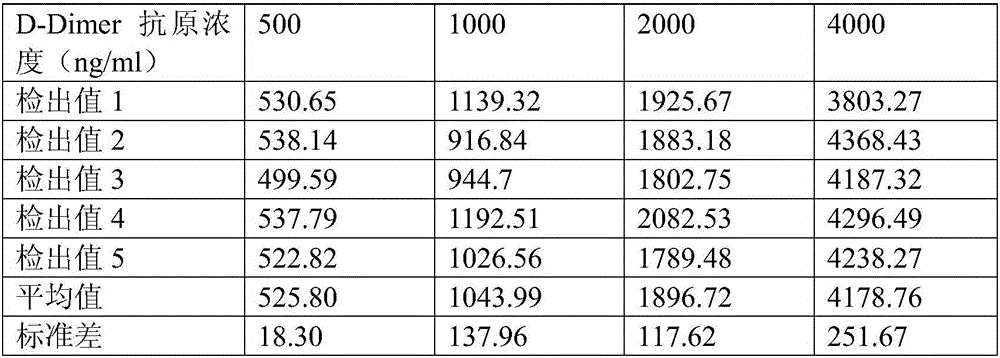Method for quantitative determination of associated antigen by means of immunomagnetic beads and application thereof
A quantitative detection and immune magnetic bead technology, which is applied in the direction of measuring devices, instruments, scientific instruments, etc., can solve the problems of low sensitivity and inability to realize quantitative detection, and achieve high sensitivity, high signal value, and accurate detection results
- Summary
- Abstract
- Description
- Claims
- Application Information
AI Technical Summary
Problems solved by technology
Method used
Image
Examples
Embodiment 1
[0048] In this embodiment, the use of immunomagnetic beads to detect D-Dimer dimer specifically includes the following steps:
[0049] (1) Choose carboxylated microspheres with a particle size of 3μm, balance the beads with 0.01M, pH 6 PBS buffer; add EDC / NHS (0.01M, pH 6 PBS buffer configuration) to make it in the system The concentration in the medium is 1mg / mL, the activation is 60min, the 0.01M, pH 6PBS buffer under the multifunctional magnetic separation rack is washed 2-3 times;
[0050] (2) Add D-Dimer coated antibody to the activated magnetic bead buffer (0.05M, pH7 MES buffer) system to make the concentration in the system 0.5mg / mL, and couple it for 4h at room temperature. Wash 2-3 times with 0.05M pH 6 MES buffer under the multifunctional magnetic separation rack; add 1% blocking solution BSA, and seal at room temperature for 40 minutes, and use 0.01M, pH 76PBS buffer under the multifunctional magnetic separation rack Wash and resuspend to obtain magnetic beads coupled ...
Embodiment 2
[0057] In this embodiment, using immunomagnetic beads to detect D-Dimer dimer antigen specifically includes the following steps:
[0058] (1) Choose carboxylated magnetic beads with a particle size of 1μm, balance the beads with 0.01M, pH 7 PBS buffer for 2-3 times; add EDC / NHS (0.01M, pH 7 PBS buffer configuration), Make the concentration in the system 0.5mg / mL, activate for 40min, wash 2-3 times with 0.01M, pH 6PBS buffer under the multifunctional magnetic separation rack to obtain activated magnetic beads;
[0059] (2) Add D-Dimer coating antibody to the activated magnetic bead buffer (0.05M, pH7 MES buffer) system to make the concentration in the system 1mg / mL, and couple for 2h at room temperature. Wash 2-3 times with 0.05M, pH6 MES buffer under the functional magnetic separation rack; add 1% blocking solution BSA, seal at room temperature for 60 minutes, and wash under the multifunctional magnetic separation rack with 0.01M, pH 7PBS buffer , Resuspend to obtain magnetic bead...
Embodiment 3
[0066] In this embodiment, using immunomagnetic beads to detect related antigens specifically includes the following steps:
[0067] (1) Choose carboxylated magnetic beads with a particle size of 200nm, balance the beads with 0.02M, pH 6 PBS buffer for 2-3 times; add EDC / NHS (0.02M, pH 6 PBS buffer configuration), Make the concentration in the system 0.1mg / mL, activate for 30 minutes, wash 2-3 times with 0.01M, pH 6PBS buffer under the multifunctional magnetic separation rack to obtain activated magnetic beads;
[0068] (2) Add D-Dimer coating antibody to the activated magnetic bead buffer (0.05M, pH6 MES buffer) system to make the concentration in the system 0.1mg / mL, and couple at room temperature for 4h, Wash 2-3 times with 0.05M pH 6 MES buffer under the multifunctional magnetic separation rack; add 1% blocking solution BSA, and block at room temperature for 40 minutes, and use 0.01M, pH 6PBS buffer under the multifunctional magnetic separation rack Wash and resuspend to obtai...
PUM
| Property | Measurement | Unit |
|---|---|---|
| particle diameter | aaaaa | aaaaa |
| particle diameter | aaaaa | aaaaa |
| concentration | aaaaa | aaaaa |
Abstract
Description
Claims
Application Information
 Login to View More
Login to View More - R&D
- Intellectual Property
- Life Sciences
- Materials
- Tech Scout
- Unparalleled Data Quality
- Higher Quality Content
- 60% Fewer Hallucinations
Browse by: Latest US Patents, China's latest patents, Technical Efficacy Thesaurus, Application Domain, Technology Topic, Popular Technical Reports.
© 2025 PatSnap. All rights reserved.Legal|Privacy policy|Modern Slavery Act Transparency Statement|Sitemap|About US| Contact US: help@patsnap.com



